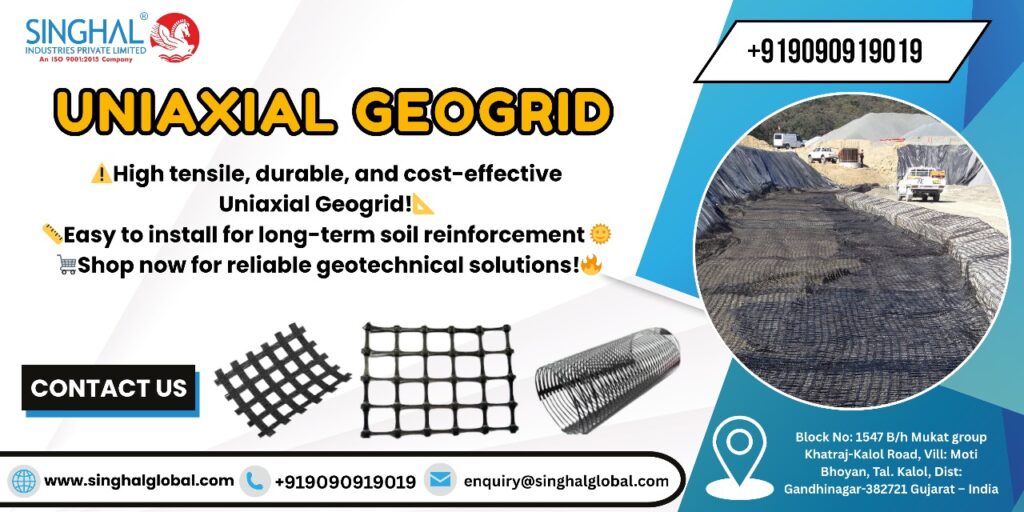In the world dominated by time, where construction projects need to be efficient, stable and economical, there is one innovation that sticks high above the rest; the Uniaxial Geogrid. As the world continues to pay more attention to environmental conservation and enhancing a good performance in the sector, Geogrid fabric in India has become a savior in contemporary engineering. Everything, highway embankments all the way to retaining walls – this geosynthetic wonder is changing how we construct.
So deep, how is Uniaxial Geogrid assisting construction and infrastructure projects in India to cut costs, improve performance and achieve ultimately long-term soil stabilization.
What is Uniaxial Geogrid?
The uniaxial geogrids are polymers manufactured to possess high tensile forces along one direction, usually the longitudinal. They are produced by punching holes in flat pieces of high-density polyethylene (HDPE) or polypropylene, and then they are stretched in a controlled fashion. What you obtain is a solid structure composed of a grid-like structure used to hold soil and distribute many loads.
One may be tempted by their simple appearance, but uniaxial geogrids are complicated machines, commonly employed to reinforce retaining walls, embankments, slope stabilization and road sub-base structures.
Why Geogrid Matters in India’s Construction Industry
The boom of infrastructure has involved India with its demerits: poor soil conditions, scarce spaces, and materials at high expenses. It is in this area that the Geogrid manufacturers in India have come in and are providing solution which substitute the traditional methods of reinforcing concrete structure and costly fill substances.
Specifically, example could be made of hilly areas such as Himachal Pradesh or the shifting slopes of Western Ghats where geogrids have enabled to build durable safe roads without having to take extensive excavation. That is not only innovation, but revolutionary.
Additionally, the cheaper Geogrid price in India has also made this high tech reinforcement method to be available even in small scale projects with the geogrid cost being locally produced.
Real-Life Example: Slope Stabilization in Maharashtra
In 2023, a project of highway construction in Maharashtra failed to resist severe erosion and movelihood of soil along 1.5 km. The traditional means such as stone pitching were useless and expensive. To strengthen the slopes, engineers decided to do it with the use of uniaxial geogrids. The result? It did not only stabilize the embankment but also saved the project 35 percent and more than 20 days of completion.
It is not only a technical victory but it is of significant importance to the safety in the streets and the budget of tax payers.
Benefits That Go Beyond Cost Savings
Although the cost saving effect is the most apparent one, uniaxial geogrids possess a variety of advantages:
- More capability to bear the load with minimum excavation
- Better stability prevalence in hooker or loose soil
- Less wearing out as time passes by
- Accelerated construction periods
- Green, less consumption of non-renewable resources
Come on, this is what engineers and architects are all about and also governments as well.
The Environmental Angle
The environmental impact of the construction industry cannot be denied. Fortunately, most geogrids manufacturers in Pakistan are currently making alternatives to eco-friendly products that are manufactured with recyclable polymers.
In addition, geogrids will require a smaller fill material thereby less soil removal and truck movement which will result to fewer emissions.
Common Applications in India
Uniaxial geogrids are flexible and they have been employed in various important sections:
- Urban infrastructure in retaining walls
- Embankment reinforcement of rails
- The construction of industrial yards Industrial yard construction
- Coastal Soil erosion control
In all these applications geogrids play the role of the invisible, but very strong force that keeps everything together.
Addressing the Cost Question
Prices of geogrid in India are determined across the material (HDPE, PP), tensile strength, roll size and application. Although this may purportedly cost a bit more in comparison to natural fill or conventional reinforcements at the very onset, however; the long-term cost-effectiveness of this in terms of lesser maintenance requirements and material demands is compensated by this advantage.
These construction managers that have switched hardly revert back.
Choosing the Right Supplier
Amidst the process of choosing the products of geogrid there are always things to look out such as:
- Tensile-strength ratings
- UV resistance
- Size and roll ease of installation
- It matches well in your soil type
Moreover, it is important to give preference to known Geogrid manufacturers in India with testing, certification and support. Having a reliable supplier would allow one to do less guessing as well as more assurance.
Conclusion
With times being such that every penny has to be counted and our environmental duty can no longer be ignored, geogrid fabric in India is becoming a wiser and a more informed way to the future. The installation is easy, performance is lasting, and the cost savings are significant; it is not just a material; uniaxial geogrids are a strategy.
Therefore, when constructing a huge flyover or constructing a small retaining wall in the rural town, it would be worthwhile to incorporate the inclusion of geogrids in the design, which are uniaxial. Your pocket book, your schedule, and your conscious will reward you.
FAQs
Q.1 How does a Uniaxial Geogrid work?
Uniaxial geogrids act by adding strength to the soil along the single direction of greatest stress (usually the length of a slope or wall). This is because when the soil area applies pressure, the load is transferred through the grids structure making it have more stability and less movement. Just imagine it as a robust net which engulfs the soil and fixes it.
Q.2 Is Uniaxial Geogrid environmental friendly or recyclable?
That is right, a lot of geogrids are recyclable polymer, e.g. in HDPE or polypropylene. Various Indian factories have turned to sustainable manufacturing processes, which means that geogrids are one of the green options in the construction setting that is targeting green certification.
Q.3 Does Uniaxial Geogrid work in any soil?
Although uniaxial geogrids work with a majority of soil types, they may perform differently in soils based on soil cohesion, soil compaction, and soil moisture content. One needs to do a site analysis and to talk to geotechnical engineers to make a decision on the grid type to use.
Q.4 What are the advantages of Uniaxial Geogrid in reducing erosions in soils?
Geogrids make the soil more stable and inhibit its operation, particularly when on slopes and embankments. Geogrids prevent erosion by rain, wind or flowing water by distributing the load as well as binding the particles together; they are an excellent solution to landslide-prone regions.









